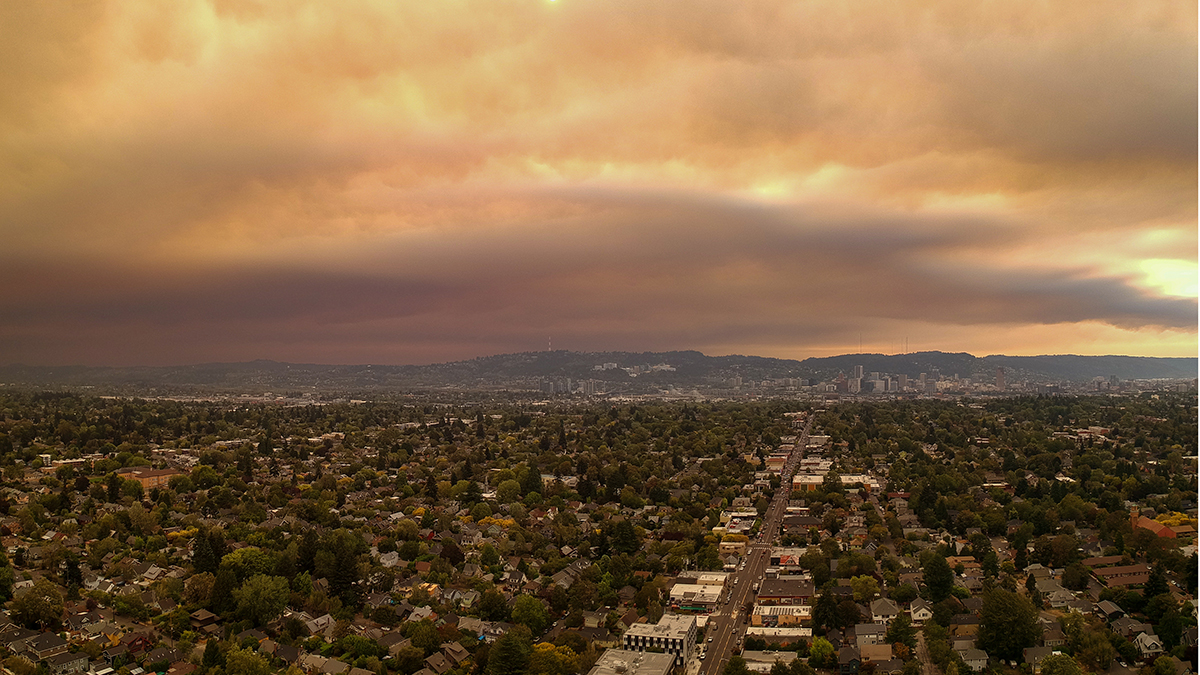A translation of this article was made possible by a partnership with Planeteando. Una traducción de este artículo fue posible gracias a una asociación con Planeteando.
Air pollution of fine particulate matter in much of the continental United States has declined over the past 30 years as power plants, cars and trucks, and industrial operations cleaned up their act. The exception? Areas with increasing incidents of wildfires, such as the Pacific Northwest. A recent analysis suggested that fine particle pollution (PM2.5) in the region could grow by 50% in the next 30 years.
The particles get deep into people’s lungs and irritate the lining.
PM2.5 is made of particles smaller than 2.5 micrometers in diameter (one thirteenth the width of a human hair) that are dangerous to inhale. The particles get deep into people’s lungs and irritate the lining, worsening lung disease, asthma attacks, and illnesses linked to heart disease.
How bad air quality in the Pacific Northwest becomes depends on the decisions of companies and governments to curb global warming, according to the latest analysis published this week in the Proceedings of the National Academy of Sciences of the United States of America. The research compared four different climate change scenarios based on emissions and land use changes, called Shared Socioeconomic Pathways, that are commonly used in climate science.
In one scenario in which nations continue burning fossil fuels to foster rapid economic growth, the planet warms by 3.3°C–5.7°C by 2100, vastly overshooting the Paris Agreement goal of limiting warming to well below 2°C. In this case, levels of fine particle pollution during August and September in the Pacific Northwest will increase by at least double the current-day levels near the end of the century.
In contrast, if world powers cut fossil fuels sharply by 2050 and achieve net zero (meaning the balance of greenhouse gases produced and removed is equal), PM2.5 will grow by about half of present-day levels by 2100. Emission cuts limit warming to 1.3°C–2.4°C in this scenario, but past decades of burning fossil fuels lock in a rise in pollution.
Doubling down on fossil fuels “is the scenario we want to make sure does not happen.”
The difference comes down to a hotter world fueling fire. Warmer climates and more available carbon dioxide influence drought and additional forest growth in the Pacific Northwest, meaning the warmer the region, the more fire, and, ultimately, the more air pollution.
For Meiyun Lin, an atmospheric scientist at NOAA and a coauthor of the latest work, the stakes are clear. “If we don’t do anything, it is a scary future,” Lin said. Doubling down on fossil fuels “is the scenario we want to make sure does not happen.”
Up in Smoke
The latest research pulled data from multiple sets of computer model simulations of climate change and wildfires over the next century. The scientists then inferred how much particle pollution the wildfires would create by using a statistical relationship that relates the amounts of wildfire carbon dioxide produced with PM2.5.
The fires of the past few years paint a picture of what may come.
Previous work found that premature deaths from PM2.5 exposure from fires in the United States could more than double, from 15,000 per year today to more than 40,000 per year by the end of the century, if emissions continue unbridled.
Wildfire smoke releases the precursors to ozone, a harmful pollutant at ground level. The models used in the study don’t predict ozone pollution from wildfires, said Lin, because the contributing factors are too complex.
The fires of the past few years paint a picture of what may come, said Lin. While residents shared pictures of red skies in 2020, daily extremes of PM2.5 rose to 95 micrograms per cubic meter, far above the U.S. National Ambient Air Quality Standard of 35 micrograms per cubic meter. Other dangerous spikes occurred in 2017, 2018, and 2021.
In one study, wildfire smoke exposure worsened the flu season.
In the scenario of unabated fossil fuel use, the study predicted that late-summer daily PM2.5 would “frequently” reach unhealthy levels of 55–150 micrograms per cubic meter.
Public health research into the toll of fine particle pollution is ongoing.
In one study analyzing a decade of data from Montana, wildfire smoke exposure worsened the flu season. Every microgram-per-meter-cubed increase in average wildfire season PM2.5 led to a 16%–22% increase in flu incidence. “What surprised us most was this really long delayed effect,” said computational ecologist Erin Landguth at the University of Montana who led the work. Although previous findings suggested that the effects of wildfire smoke could linger for days to weeks, she and her colleagues discovered adverse effects 1–3 months later.
—Jenessa Duncombe (@jrdscience), Staff Writer

